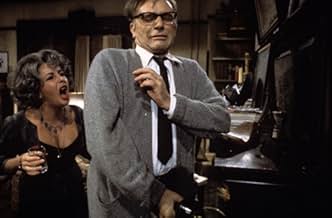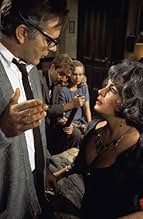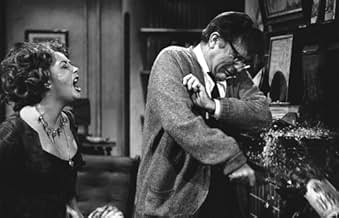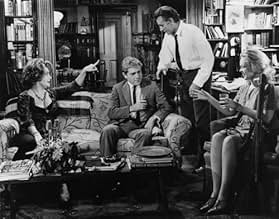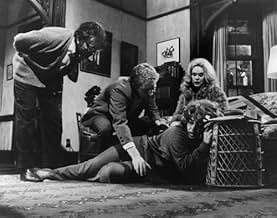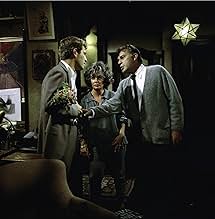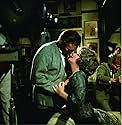Un couple amer et vieillissant, l'alcool aidant, se sert d'un jeune couple pour alimenter l'angoisse et la douleur émotionnelle qu'ils ressentent l'un envers l'autre.Un couple amer et vieillissant, l'alcool aidant, se sert d'un jeune couple pour alimenter l'angoisse et la douleur émotionnelle qu'ils ressentent l'un envers l'autre.Un couple amer et vieillissant, l'alcool aidant, se sert d'un jeune couple pour alimenter l'angoisse et la douleur émotionnelle qu'ils ressentent l'un envers l'autre.
- Réalisation
- Scénario
- Casting principal
- Récompensé par 5 Oscars
- 22 victoires et 26 nominations au total
Avis à la une
Edward Albee's award winning play, Who's Afraid of Virginia Woolf ran for 664 performances on Broadway and just closed down when this film version made its debut in 1966. The Broadway play was set entirely in the living room of George and Martha's home and starred Uta Hagen, Arthur Hill, Melinda Dillon, and George Grizzard. All eminently respectable players, but none of them exactly movie box office.
This film was destined to make money when the most publicized couple of the decade, Elizabeth Taylor and Richard Burton, chose it as a star vehicle for themselves. Of course what was not clear was how well a one stage play would adapt to film.
It adapted very well and went quite beyond one stage. The action of the film moved effortlessly to an all night diner at one point with some stops along the way. You'd hardly know the story as originally told only had one setting.
There's no real plot to it. For reasons I can't fathom this middle aged and bitter couple George and Martha have a younger couple, Nick and Honey, over to their house at two in the morning. I don't know about you, but I'm usually not my best at that time. Also they had just come from a party at Martha's father's house. Martha's dad is the president of a college and George teaches there. Nick and Honey are a newly hired professor and his wife.
The late night and the liquor bring out the worst in everybody. A whole lot of ugly truths get told.
Who's Afraid of Virginia Woolf was the summit of the professional team of Elizabeth Taylor and Richard Burton. Playing against type, Elizabeth Taylor got her second Oscar the one she felt she earned. She always disparaged the one received for Butterfield 8 as it came on the heels of her well publicized pneumonia bout.
In fact all four members of the cast were nominated with Sandy Dennis winning Best Supporting Actress. Ironically Richard Burton didn't win, losing to Paul Scofield for A Man for All Seasons. I guess the Academy voters figured Burton would get another shot. He never brought home the big prize though.
George Segal usually gets overlooked. This film and Ship of Fools was the start of his long career, but no Oscar for him either.
Who's Afraid of Virginia Woolf is quite the indictment against marriage, especially after the love has died. It's far from the whole story of marriage. There are many who stay married longer than George and Martha and happily. But it wasn't in Edward Albee's life experience to draw from.
But this should be seen to see Liz and Dick at their very best.
This film was destined to make money when the most publicized couple of the decade, Elizabeth Taylor and Richard Burton, chose it as a star vehicle for themselves. Of course what was not clear was how well a one stage play would adapt to film.
It adapted very well and went quite beyond one stage. The action of the film moved effortlessly to an all night diner at one point with some stops along the way. You'd hardly know the story as originally told only had one setting.
There's no real plot to it. For reasons I can't fathom this middle aged and bitter couple George and Martha have a younger couple, Nick and Honey, over to their house at two in the morning. I don't know about you, but I'm usually not my best at that time. Also they had just come from a party at Martha's father's house. Martha's dad is the president of a college and George teaches there. Nick and Honey are a newly hired professor and his wife.
The late night and the liquor bring out the worst in everybody. A whole lot of ugly truths get told.
Who's Afraid of Virginia Woolf was the summit of the professional team of Elizabeth Taylor and Richard Burton. Playing against type, Elizabeth Taylor got her second Oscar the one she felt she earned. She always disparaged the one received for Butterfield 8 as it came on the heels of her well publicized pneumonia bout.
In fact all four members of the cast were nominated with Sandy Dennis winning Best Supporting Actress. Ironically Richard Burton didn't win, losing to Paul Scofield for A Man for All Seasons. I guess the Academy voters figured Burton would get another shot. He never brought home the big prize though.
George Segal usually gets overlooked. This film and Ship of Fools was the start of his long career, but no Oscar for him either.
Who's Afraid of Virginia Woolf is quite the indictment against marriage, especially after the love has died. It's far from the whole story of marriage. There are many who stay married longer than George and Martha and happily. But it wasn't in Edward Albee's life experience to draw from.
But this should be seen to see Liz and Dick at their very best.
10OttoVonB
Ailing couple George (Burton) and Martha (Taylor) invite a young couple over for a late-night drink - much to quiet and repressed George's annoyance - and what starts off as a twisted game by sultry Martha to annoy her husband and get her way with young stud Nick (George Segal) ends up in a horrific duel of wits.
Adapted from the play and boasting very few locations, "Virginia Woolf" is notable for many unsuspected reasons. Designed for the stage, the film makes the story uniquely cinematic and tense, amped up by stunning photography (in Black and White, a daring choice in 1966). The younger leads are superb, but Burton and Taylor still manage to walk away with film, giving stunning renditions of the world's most demented couple. They make the surreal dialogue hurt and touch in ways never thought possible.
Though there are countless reasons to recommend this jewel of a film, there are also reasons why one would wish to avoid it. This is the kind of film that makes you feel like having a showing (or a very concentrated drink) to wash away the grit and human evil and pain absorbed. You'll feel dirty, but in a way you'll also feel enlightened: that a small character film can carry more punch than any explosion-packed blockbuster out there is a thing of beauty indeed!
Adapted from the play and boasting very few locations, "Virginia Woolf" is notable for many unsuspected reasons. Designed for the stage, the film makes the story uniquely cinematic and tense, amped up by stunning photography (in Black and White, a daring choice in 1966). The younger leads are superb, but Burton and Taylor still manage to walk away with film, giving stunning renditions of the world's most demented couple. They make the surreal dialogue hurt and touch in ways never thought possible.
Though there are countless reasons to recommend this jewel of a film, there are also reasons why one would wish to avoid it. This is the kind of film that makes you feel like having a showing (or a very concentrated drink) to wash away the grit and human evil and pain absorbed. You'll feel dirty, but in a way you'll also feel enlightened: that a small character film can carry more punch than any explosion-packed blockbuster out there is a thing of beauty indeed!
"Who's Afraid of Virginia Woolf?" walks a tightrope between comedy and tragedy. But regardless of the laughter this dark comedy elicits, we can all agree on one unanimous opinion: it's utterly terrifying.
"Terrifying" is a term too light, a shade too gray to stand out amid the dazzling kaleidoscope of emotions within this film.
The story in "Who's Afraid of Virginia Woolf?" unfolds over one night, as one crisis compounds onto another. George and Martha are a middle-aged couple, clearly losing their affection for each other. After a university party, they reluctantly invite another couple, Nick and Honey, to their home. Under the influence of alcohol and the fatigue of the late hour, every conflict, disagreement, and hidden facet of George-Martha and Nick-Honey's marriages gradually unravel in the most damaging ways.
Virginia Woolf was a prolific writer whose style delves deep into the thoughts of each character, exposing the reality of who they are. "Who's afraid of Virginia Woolf?" can be understood as "Who's afraid of living without illusion?" Do you remember Martha's response to George's question at the end of the film? George places his hand on Martha's shoulder and softly sings, "Who's afraid of Virginia Woolf?" Martha replies, "I am, George, I am." It signifies the confrontation between reality and illusion. But who doesn't have moments of fearing reality and escaping into illusions? Yet, the illusion in their minds often remains separate from reality. Unlike Martha and George, who embed illusions into their daily lives too frequently, to the point where Martha believes them to be real. So when she hears news of her son's death, she cries not because her illusion has shattered, but out of pity for that blend of illusion and reality. Her son might have been an illusion, but her suffering was real.
The film's characters feel remarkably authentic as well. They lack the flamboyant personas we often encounter in cinema; they could be anyone, neither entirely virtuous nor inherently wicked, neither deserving of our sympathy nor our ire. They are simultaneously relatable and infuriating, each simply navigating their own slice of life. This authenticity injects a profound sense of realism into the narrative, stripping away any semblance of fiction. While their story may not venture into uncharted territory, the interactions and conflicts between these characters elevate it to new heights, especially the portrayal of Liz Taylor's Martha. Her fiery temperament, piercing voice, seething anger, resentful glances at George, the ceaseless flow of alcohol, the chain of cigarettes, and the tears-all of these elements contribute to the film's atmosphere of stagnation.
The film's gripping intensity can be traced back to its theatrical origins. In the world of theater, we anticipate climaxes, revelations, and resolutions. With each passing moment, tension mounts, growing increasingly oppressive until it reaches a point where we must acknowledge that it cannot be neatly resolved. "Who's Afraid of Virginia Woolf?" transcends the boundaries of mere cinema; it's an unsettling voyage into the delicate equilibrium between illusion and reality. Within its intricate layers, terror and humor seamlessly intertwine, crafting a cinematic experience that leaves an enduring imprint.
"Terrifying" is a term too light, a shade too gray to stand out amid the dazzling kaleidoscope of emotions within this film.
The story in "Who's Afraid of Virginia Woolf?" unfolds over one night, as one crisis compounds onto another. George and Martha are a middle-aged couple, clearly losing their affection for each other. After a university party, they reluctantly invite another couple, Nick and Honey, to their home. Under the influence of alcohol and the fatigue of the late hour, every conflict, disagreement, and hidden facet of George-Martha and Nick-Honey's marriages gradually unravel in the most damaging ways.
Virginia Woolf was a prolific writer whose style delves deep into the thoughts of each character, exposing the reality of who they are. "Who's afraid of Virginia Woolf?" can be understood as "Who's afraid of living without illusion?" Do you remember Martha's response to George's question at the end of the film? George places his hand on Martha's shoulder and softly sings, "Who's afraid of Virginia Woolf?" Martha replies, "I am, George, I am." It signifies the confrontation between reality and illusion. But who doesn't have moments of fearing reality and escaping into illusions? Yet, the illusion in their minds often remains separate from reality. Unlike Martha and George, who embed illusions into their daily lives too frequently, to the point where Martha believes them to be real. So when she hears news of her son's death, she cries not because her illusion has shattered, but out of pity for that blend of illusion and reality. Her son might have been an illusion, but her suffering was real.
The film's characters feel remarkably authentic as well. They lack the flamboyant personas we often encounter in cinema; they could be anyone, neither entirely virtuous nor inherently wicked, neither deserving of our sympathy nor our ire. They are simultaneously relatable and infuriating, each simply navigating their own slice of life. This authenticity injects a profound sense of realism into the narrative, stripping away any semblance of fiction. While their story may not venture into uncharted territory, the interactions and conflicts between these characters elevate it to new heights, especially the portrayal of Liz Taylor's Martha. Her fiery temperament, piercing voice, seething anger, resentful glances at George, the ceaseless flow of alcohol, the chain of cigarettes, and the tears-all of these elements contribute to the film's atmosphere of stagnation.
The film's gripping intensity can be traced back to its theatrical origins. In the world of theater, we anticipate climaxes, revelations, and resolutions. With each passing moment, tension mounts, growing increasingly oppressive until it reaches a point where we must acknowledge that it cannot be neatly resolved. "Who's Afraid of Virginia Woolf?" transcends the boundaries of mere cinema; it's an unsettling voyage into the delicate equilibrium between illusion and reality. Within its intricate layers, terror and humor seamlessly intertwine, crafting a cinematic experience that leaves an enduring imprint.
This is still an exceptional film from the 1960s. Though some of the epithets are obviously softening much stronger words, the language is frank and brutal, Martha's bludgeoning body-blows balanced by George's icepick thrusts. Edward Lehman's respectful screenplay gently opens up Edward Albee's one-set play while keeping a certain claustrophobic atmosphere. Mike Nichols' first directing effort is stunning in its lack of artifice; rarely do you feel that the director has done much more than turn on the camera and watch four actors, all at the top of their game, tear into their roles. George Segal's work in this movie is criminally underrated, but his reactive work as studly, ultimately disappointing Nick should be mandatory study by all young actors. Sandy Dennis' fluttery turn as mousy, wifey Honey is powerful also; a lot more is going on than you might think. Richard Burton is staggering as George ("Georgie Porgie Put-upon Pie"), and his performance demonstrates the magic that he could bring to a worthy role. Elizabeth Taylor's work here still astounds. The physical transformation she undertook to become aging harpy Martha is amazing enough, but her performance seems to channel a hurricane's force and fury. By turns hilarious, maddening and then, at the end, exhausted and defeated yet again, Taylor demonstrates acting, particularly film acting, at its best. The film is by no means easy or "Hollywood" in feel-- the audience is as exhausted as the characters at the end. But this was a bracing, necessary antidote to the impossible ideal of marriage usually portrayed in the movies. A towering film.
10Rathko
An undisputed classic that chronicles every appalling moment of a drunken night in hell as middle-aged George and Martha tear each other, and their guest, to pieces.
Elizabeth Taylor proves categorically that she was a truly great actress. Her Oscar-winning performance as the psychologically tormented Martha is one of the greatest performances in the history of cinema. Taylor's imperceptible shifting from sadism to tenderness, from bullying condescension to exhausted vulnerability, is a masterclass in character building. Martha is a truly monstrous character, and yet Taylor is able to imbue her with sympathy, allowing you brief glimpses of the warm and lovable woman she could have been.
Richard Burton is equally magnificent as George; an ageing, failing college professor whose initial meekness gives way to a raging torment all of his own. His verbal sparring with Taylor, like two pit-bulls in the ring of an endless and bloody dogfight, has become legendary. Every word drips with malice and contempt, every sentence is designed to cut the deepest wound. At times, it becomes painful to watch, but like true train-wreck television, you cannot drag yourself away from the inevitably terrible conclusion.
Quite possibly, this is as close to perfect as movies can get; beautifully written dialogue, deeply complex characters, an evolving and suspenseful storyline, beautiful photography, and a wonderfully understated score by Alex North. Nominated for 13 Academy Awards in 1967, but lost out to A Man for All Seasons and Born Free to win only 5.
"Who's Afraid of Virginia Woolf?" "I am."
Elizabeth Taylor proves categorically that she was a truly great actress. Her Oscar-winning performance as the psychologically tormented Martha is one of the greatest performances in the history of cinema. Taylor's imperceptible shifting from sadism to tenderness, from bullying condescension to exhausted vulnerability, is a masterclass in character building. Martha is a truly monstrous character, and yet Taylor is able to imbue her with sympathy, allowing you brief glimpses of the warm and lovable woman she could have been.
Richard Burton is equally magnificent as George; an ageing, failing college professor whose initial meekness gives way to a raging torment all of his own. His verbal sparring with Taylor, like two pit-bulls in the ring of an endless and bloody dogfight, has become legendary. Every word drips with malice and contempt, every sentence is designed to cut the deepest wound. At times, it becomes painful to watch, but like true train-wreck television, you cannot drag yourself away from the inevitably terrible conclusion.
Quite possibly, this is as close to perfect as movies can get; beautifully written dialogue, deeply complex characters, an evolving and suspenseful storyline, beautiful photography, and a wonderfully understated score by Alex North. Nominated for 13 Academy Awards in 1967, but lost out to A Man for All Seasons and Born Free to win only 5.
"Who's Afraid of Virginia Woolf?" "I am."
Le saviez-vous
- AnecdotesThis became the first movie in Academy Awards history since Cimarron (1931) to be nominated for every Academy Award category in which it was eligible, including Best Adapted Screenplay (Ernest Lehman), Director (Mike Nichols), all of the acting categories (Richard Burton, Dame Elizabeth Taylor, George Segal and Sandy Dennis) and Picture of the Year (Ernest Lehman).
- GaffesThe four characters stop at a bar after the first soiree at George's house. It is clearly after 2:00 a.m., since the time was stated during the first segment. No bars, however, would have been open after 1 or 2 a.m. in the New England states, where the film is set.
- ConnexionsEdited from La Lettre (1940)
- Bandes originalesWho's Afraid of Virginia Woolf?
(to the tune of "Here We Go Round the Mulberry Bush")
Traditional English melody
Original lyrics ("Who's Afraid of the Big Bad Wolf?") by Frank Churchill and Ann Ronell; modified by Edward Albee
Performed by Elizabeth Taylor
Meilleurs choix
Connectez-vous pour évaluer et suivre la liste de favoris afin de recevoir des recommandations personnalisées
- How long is Who's Afraid of Virginia Woolf??Alimenté par Alexa
- What is "Who's Afraid of Virginia Woolf" about?
- Is "Who's Afraid of Virginia Woolf" based on a book?
- From what movie does Martha's quote "What a dump!" come?
Détails
- Date de sortie
- Pays d’origine
- Langues
- Aussi connu sous le nom de
- ¿Quién le teme a Virginia Woolf?
- Lieux de tournage
- Cambridge, Massachusetts, États-Unis(location)
- Sociétés de production
- Voir plus de crédits d'entreprise sur IMDbPro
Box-office
- Budget
- 7 500 000 $US (estimé)
- Montant brut aux États-Unis et au Canada
- 28 000 000 $US
- Montant brut mondial
- 28 007 258 $US
- Durée2 heures 11 minutes
- Couleur
- Mixage
- Rapport de forme
- 1.85 : 1
Contribuer à cette page
Suggérer une modification ou ajouter du contenu manquant

Lacune principale
By what name was Qui a peur de Virginia Woolf? (1966) officially released in India in English?
Répondre

